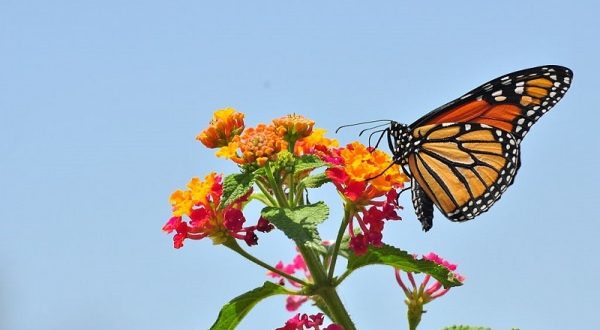Scientists from the University of Washington have discovered the secrets of the monarch butterfly’s inner, genetically encoded compass that they use to determine the direction .
When the leaves fall to the ground in August, monarch butterflies all over Canada and the United States face the Rio Grande and make a beeline for Mexico. They travel some 2000 odd miles and reach their destination in the end.
“Their compass integrates two pieces of information — the time of day and the sun’s position on the horizon — to find the southerly direction,” said Eli Shlizerman, a University of Washington assistant professor.
While the nature of the monarch butterfly’s ability to integrate the time of day and the sun’s location in the sky are known from previous research, scientists have never understood how the monarch’s brain receives and processes this information. Shlizerman, who has joint appointments in the Department of Applied Mathematics and the Department of Electrical Engineering, partnered with colleagues at the University of Michigan and the University of Massachusetts to model how the monarch’s compass is organized within its brain.
“We wanted to understand how the monarch is processing these different types of information to yield this constant behavior — flying southwest each fall,” said Shlizerman, who is lead author on the team’s April 14 paper in the journal Cell Reports.
Monarchs use their large, complex eyes to monitor the sun’s position in the sky. But the sun’s position is not sufficient to determine direction. Each butterfly must also combine that information with the time of day to know where to go. Fortunately, like most animals including humans, monarchs possess an internal clock based on the rhythmic expression of key genes. This clock maintains a daily pattern of physiology and behavior. In the monarch butterfly, the clock is centered in the antennae, and its information travels via neurons to the brain.
Biologists have previously studied the rhythmic patterns in monarch antennae that control the internal clock, as well as how their compound eyes decipher the sun’s position in the sky. Shlizerman’s collaborators, including Steven Reppert at the University of Massachusetts, recorded signals from antennae nerves in monarchs as they transmitted clock information to the brain as well as light information from the eyes.
“We created a model that incorporated this information — how the antennae and eyes send this information to the brain,” said Shlizerman. “Our goal was to model what type of control mechanism would be at work within the brain, and then asked whether our model could guarantee sustained navigation in the southwest direction.”
In their model, two neural mechanisms — one inhibitory and one excitatory — controlled signals from clock genes in the antennae. Their model had a similar system in place to discern the sun’s position based on signals from the eyes. The balance between these control mechanisms would help the monarch brain decipher which direction was southwest.
Based on their model, it also appears that when making course corrections monarchs do not simply take the shortest turn to get back on route. Their model includes a unique feature — a separation point that would control whether the monarch turned right or left to head in the southwest direction.
“The location of this point in the monarch butterfly’s visual field changes throughout the day,” said Shlizerman. “And our model predicts that the monarch will not cross this point when it makes a course correction to head back southwest.”
Based on their simulations, if a monarch gets off course due to a gust of wind or object in its path, it will turn whichever direction won’t require it to cross the separation point.
Additional studies would need to confirm whether the researchers’ model is consistent with monarch butterfly brain anatomy, physiology and behavior. So far, aspects of their model, such as the separation point, seem consistent with observed behaviors.
“In experiments with monarchs at different times of the day, you do see occasions where their turns in course corrections are unusually long, slow or meandering,” said Shlizerman. “These could be cases where they can’t do a shorter turn because it would require crossing the separation point.”
Their model also suggests a simple explanation why monarch butterflies are able to reverse course in the spring and head northeast back to the United States and Canada. The four neural mechanisms that transmit information about the clock and the sun’s position would simply need to reverse direction.
“And when that happens, their compass points northeast instead of southwest,” said Shlizerman. “It’s a simple, robust system to explain how these butterflies — generation after generation — make this remarkable migration.”
Agencies/Canadajournal
 Canada Journal – News of the World Articles and videos to bring you the biggest Canadian news stories from across the country every day
Canada Journal – News of the World Articles and videos to bring you the biggest Canadian news stories from across the country every day




The Monarch Butterfly in North America is the only migrating insect in the world. It weights on average 0.5 grams. There are usually 5 generations born per year. Four generations only live one month on average but the fifth generation ( born in August) is the migrating one and lives for 8 months, surviving winter by clinging to trees in Mexico and when the longer and warmer days of spring arrive, they depart Mexico on their way northward again and breeding along the way. They end up dying in the Texas area where a new generation takes over and eventually the third or fourth generation reach Canada in early June. The Monarch is under a lot of pressure to survive with illegal logging in the Mexican mountains, Chemical spraying in Texas and elsewhere. The butterfly lays its eggs on the Milkweed Plant, the only plant it uses and the only plant the caterpillar eats. A truly phenomenal insect and one deserving our help to survive. We can all help by planting summer flowers and even the Milkweed Plant.